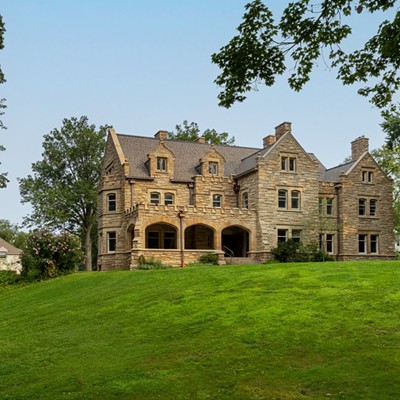Sommer embraced the populist themes of his time; one of his Works Progress Administration-sponsored murals hangs at the Cleveland Public Library. But his best work boasts a combination of poetry and pragmatism that resists easy categorization. Indeed, the quietly ecstatic view of life in many of these watercolors has more in common with the nineteenth-century transcendentalism of Emerson than it does with the fireside chats of F.D.R. Before he was through, Sommer rendered Brandywine Valley, thirty miles south of Cleveland, as though it were a corner of paradise.
The cross section of Sommer works on display at the Beck Center includes both early oils and the later watercolors on which his reputation mainly rests. Included are works from the Detroit native's early stint at a Munich art school, as well as the more sophisticated paintings that he created after moving to Cleveland in 1907 and striking up friendships with local artists like Abel Warshawsky and William Zorach. These artists introduced the then-forty-year-old Sommer to French impressionism and post-impressionism, and for several years he seemed engrossed with the problem of how to be an American artist not merely in subject but in form. It wasn't until 1930, when Sommer was 63, that he hit his stride and began rendering the expressive watercolors that transformed Ohio's brooks and dells into the nooks and crannies of an impossibly bounteous American paradise.
Sommer was a commercial lithographer by trade, and one of the interesting ironies of this retrospective is that the pantheistic works on display came from a man whose day job engaged his mind but not his soul (something about which Sommer was despondent). One needn't look far to cite another American career similarly blighted--Charles Ives, one of American music's true originals, sold insurance during the week and on weekends composed works with names like "Universe Symphony."
The winding path Sommer took to his serene (but not somnolent) watercolors is suggested by the earlier works on display, miniature battlefields on which struggles between technique and expressive design take place. For example, the 1911 oil painting "Lake Erie Cliff, Lakewood," records a three-front skirmish between thick, impetuous brushwork, an impressionistic exploitation of color, and the piquant notion that Lake Erie and Lakewood are no less French than the Seine and Paris. Boding well for Sommer, though, is the keen compositional sense already in evidence. Though "Lake Erie Cliff" is seemingly divided into halves--the cliff and the sky-blue lake--it's actually an intricate study in how color can serve both a decorative and a compositional purpose. The blue and purple tones of the expansive sky on the right half of the frame are echoed briefly at the left, as a small piece of sky peeks through a dense mass of foliage. With this passage, Sommer provides the eye with the means to link the halves of the frame.
During the 1920s, Sommer made great progress in combining the influences that informed his work. That point is driven home in a fine exhibition essay by Wendy Kendall-Hess, former assistant curator of the Akron Art Museum. Kendall-Hess argues that Sommer blended the cubist impulse to subdivide objects into their component geometrical parts with the vivid color rhythms and flatly rendered forms found in the works of post-impressionist painters like Edouard Manet.
Even the 1920 watercolor "Rooster Under Apple Tree," a piece that presumably predates the struggle which Kendall-Hess discusses, seems to telegraph Sommer's mature style a full ten years before the fact. The image is simplicity itself: a rooster and a series of trees that all bear bright, shiny red apples. The fleshy crescent surmounting the rooster's head is the same shade of red as the apples, and the branches have filaments of red along with the expected shafts of brown. Sommer captures in this mundane scene a sense of inexhaustible plenty. In spirit it's similar to the landscapes painted by the nineteenth-century English artist Samuel Palmer, who spoke of his "valley of vision": brooks and dells full of fruits and flowers, which seemed charged with spiritual implications. Sommer updates the idea, but adds a Middle-American twist.
Sommer also uses animals as icons for the elemental forces of nature, including purple cows and domestic dogs. The 1932 watercolor "Waiting to Go to the Barn," for instance, seems to have been drawn from the point of view of the horse at the far right of the frame. The anticipation suggested in the title isn't the owner's; he's nowhere in sight. It's the horse with the noble mane who's waiting to go to the barn, and this is a small watercolor with a big theme: The farmer literally harnesses nature for his use, but nature cannot be owned and always has a way of reasserting its identity. Sommer always seems willing to test the boundaries of his medium, even if he doesn't always do it in a nuanced way.
Sweeping statements crop up fairly often in Sommer's works, though they typically square poorly with his subtle compositional and coloristic gifts. He's at his best when he extracts the significant from the commonplace, but falters when he attempts to pump up the commonplace beyond what it can handle. In those cases, a Pollyannaish quality creeps into the work--imagine a Jimmy Stewart in It's a Wonderful Life who'd never heard of Mr. Potter. A watercolor of Sommer's wife is typical of his misses. "Mrs. Sommer Reading" shows the bespectacled woman turning the page of a book; there's an apple next to the heavy tome, and the page that's just been turned echoes the rounded form of the apple. The expected connection between apples and knowledge is thereby hammered home.
Apples are everywhere in these works, and Sommer seems to have delighted in their roundness, their redness, and the way their shiny skin reflects light. The famous twentieth-century American poet Hart Crane, one of Sommer's friends, once dedicated a poem to the artist called "Sunday Morning Apples." Its closing lines are worth repeating, because in them Crane captured the middle-class pantheism which is Sommer's most distinctive contribution to mid-century regional art: "Put them again beside a pitcher with a knife/And poise them full and ready for explosion/The apples, Bill, the apples!"
Crane's "explosion" seems to refer to the way nature's bounty bursts forth when it's ready to blossom. Similarly, in Crane's view, Sommer is almost God-like when he writes or paints, because he can make the explosion happen by carefully arranging his materials. Crane was clearly attuned to the big picture in his friend's work, and his poem, on display as part of this exhibit, represented empathic identification of a very high order.
Weekend visionaries like Ives and Sommer--artists who divide their loyalties between a stifling day job and an idealistic night life--will always face the charge that they created much but reflected little. The Beck Center's retrospective is instructive in this regard. Here is self-contained art that changed dramatically at the outset (as a result of a great deal of reflection and immersion in avant-garde styles), but which, once it had found its spiritual engine, steadily held its course and developed a soft-spoken authority. The dust-bowl days were a time of deprivation for many Americans, yet Sommer found comfort and sustenance in Brandywine and his fruit-laden watercolors. It's always an important event when art so private transcends the conditions under which it was created, and this Beck Center retrospective reminds us why.
William Sommer and the Brandywine Vision, through June 27 at the Beck Center Gallery, 17801 Detroit Avenue, Lakewood, 216-227-9507.











